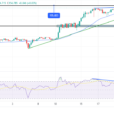Investors are well-aware of the numerous industrial applications for silver, and it often factors into analysis of the white metal’s demand. But gold also has industrial applications. And while investment and jewelry primarily drive the demand for gold, its use in industrial applications continues to expand, representing a growing market for the precious metal.

Gold nanoparticles are increasingly used in medical applications and electronics, and according to recently released market analysis by research firm Radiant Insights, the demand for gold nanoparticles is expected to grow to $4.99 billion by 2020.
High-tech applications in the electronics and computer industries drive gold’s industrial demand. The metal’s conductivity and corrosion resistance make it an ideal material for manufacturing high-specification components. Radiant Insights expects growth in this sector to continue:
With constant innovation and increasing demand for smaller, versatile and smarter devices the global electronics industry is expected to be one of the fastest growing gold nanoparticle markets. There has been a surge in demand for this technology, especially gold nanoparticle inks for storage devices, hard disks and microchips among others. These inks have also found applications in thin film transistors and photovoltaic, photo-sensors and detectors.”
The fastest growing application for industrial gold is in the medical field. Gold nanoparticles are used in drug delivery systems and nanomedicines. Global nanoparticle demand in biotechnology, drug development and drug delivery will likely grow to $90 billion by 2020, according to Radiant Insights analysis.
The World Gold council also predicts continued growth in gold’s medical applications:
A range of healthcare and catalytic applications for gold is currently being developed as the field of nanotechnology expands. While this demand is still small in tonnage terms, the growing number of patents being published relating to gold nanotechnology suggests many new applications will be developed in the coming years.”












Leave A Comment